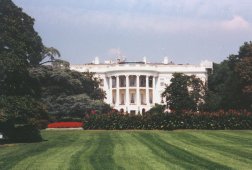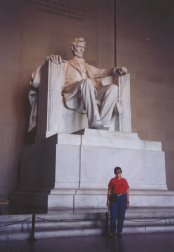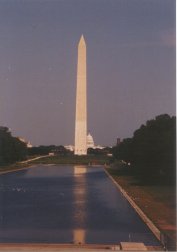September 1997
<<<
Monday, 1 September 1997 - Valerie's birthday
The Basketville shop just outside Putney, VT claims
to have the largest basket range in the world, if you cannot find the basket you
are looking for here you will not find it anywhere. Unfortunately, Valerie took
a fancy to the wicker furniture but she could not figure out how to fit it into
the RV. Evening meal out to celebrate.
Tuesday, 2 September 1997
|
We saw the first hint of autumn as we drove the
110 miles from Putney in a south-easterly
direction into
Massachusetts were a few maple trees,
particularly those along the edge of lakes were
already beginning to turn a brilliant red. It's
a pity but we are unlikely to be able to see the
fall at its best, which is normally late
September since we need to be in California
by early October.
|
|
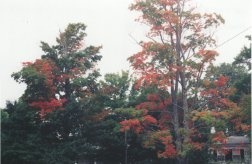
|
Wednesday, 3 September 1627
The observant reader would have noticed that today we have travelled back 370
years, which is how it felt to us during our visit to the
Plymouth Plantation near
Plymouth, MA.
The plantation contains a recreation of a 1679 village depicting how the
Pilgrims of Plymouth lived which is done in a very life-like and
professional manner. In numerous locations throughout the village characters
dressed in traditional dress were participating in activities typical of the
time. The pilgrims in the village know nothing beyond the year 1627, in fact, no
matter how hard you try it is impossible to trick the actors out of their roles.
We first encountered two characters building a wooden house, who had very strong
London accents and were talking about the ship just in from England.
|
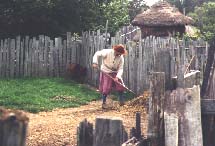
|
We spent about 20 minutes inside a small house
with a dirt floor talking to a lady with a north
English accent while she prepared lunch on a log
fire. We learnt about what Herb was used in
treating various illnesses and the typical diet.
What was interesting was that flies were
crawling all over the ingredients and cooked
food but the lady of the time just ignored the
flies as they do not eat very much!
|
About three miles along the coast is the Mayflower II
which was built in England and sailed to Boston in 1957, it is a full-size
reproduction of the ship that brought the 102 Pilgrims to America in 1620. The
thing that makes the most impact is realising how small the ship was for the 150
passengers and crew who had to endure the eleven-week crossing.
Another two miles along the coast we came across the
Ocean Spray Cranberry Museum.
Cranberries, which were introduced to the Europeans by the Indians, are grown in
sand-covered peat bogs which are harvested in September by flooding the field
and then the berries are stripped from the 6-inch tall plants by rotating
paddles so that they float to the top and are easily scooped up. It's a vast
industry with most of the output being turned into drink, however, George
preferred the cranberry bread pudding, which was on offer.
Thursday, 4 - Friday, 5 September 1997
With vague memories of the Boston Tea Party, we were looking forward to
exploring the city which unlike most American cities with straight roads
intersecting at right angles, turned out to be a sprawling confusing mass of
busy roads twisting in all directions - it must be the earlier British
influence! There was hardly a sign anywhere and certainly none to help the
first-time tourist, in other words, we got well and truly lost. It may not have
been so bad if it was not for roadworks at every junction we wanted to take.
More by luck than our judgment we found ourselves in the centre of the 3-mile
Freedom Trial which is a pleasant walk covering 20
of Boston's most historic points of interest. Fortunately once on the
trail, it is well marked by a red line which in no time led us into an Italian
area which must have more Italian restaurants than any place outside Italy, the
aroma was just too much so in no time we were both eating a delicious panini.
One of the first places we visited was the Copp's Hill
burial ground where a notice recorded that the three annoyances of the day were
wolves, rattlesnakes and mosquitoes. Later on, we learned that the growing
animosity to unpopular British taxes brought military occupation to Boston in
1768, further fuelling Colonial resentment of Crown rule. In 1770 British
soldiers fired on a belligerent mob, killing five citizens in what became
described as the Boston Massacre. Three years later patriots loosely
disguised as Indians dumped three shiploads of taxable tea into Boston
Harbour. Furious, Parliament retaliated by closing the city's port. Violent
protests finally led to an armed confrontation on nearby
Lexington Green the morning after Paul
Revere's famous midnight ride (The British are coming), sparking the American
Revolution. Boston has managed to retain a lot of this history but today
is probably more famous for Harvard University
and more than 50 local universities and colleges as well as the 700 high-tech
companies that have settled nearby.
|
Boston
has a huge and famous harbour which includes a
naval shipbuilding yard with a history going
back to the formation of America.
Built-in Boston and known throughout the
world is the
USS Constitution which along with five other
frigates was commissioned in 1794, today the
ship is so well preserved that it looked as good
as new.
|
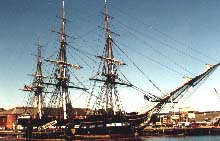
|
So while Valerie watched the sailors climbing the rigging, George toured the
USS Constitution which is the oldest fully commissioned warship in the world
and is still a part of the US Navy. The ship has three sailing masts and 24 huge
cannons which can fire 32-pound solid shots which explains why she was never
defeated. Her wooden sides were so thick that British cannon shots could not
penetrate, earning her the nickname - Old Ironsides.
A modern-day tradition is that every July 4th the ship is turned around in the
bay to even out the effects of the weather, which is an opportunity to have a
party celebrating beating the British.
An interesting side piece of information gathered during the visit was that
America's national anthem, the Star Spangled Banner adopted in 1931, was
originally a poem written in 1814 to commemorate America's victory in Baltimore
over the British.
Saturday, 6 September 1997
We would have liked to have spent another day exploring Boston but it had
been an exhausting couple of days so after some discussion and hesitation as to
what direction we should move tomorrow, we decided that as we were unlikely to
have another opportunity to visit the northeastern corner of the states, we
would travel further north and visit at least parts of
New Hampshire and possibly Maine. After
replacing the sewer hose yet again, we departed at around 09.30 and by
lunchtime, we arrived in North Woodstock
some 170 miles to the north. We were fascinated to see shortly after crossing
the state line into New Hampshire (Live Free or Die) a very large sign
stating that there was a state liquor store at the next rest area! We of course
stopped and found a liquor store that would have done justice to a large
duty-free shop at an international airport. We find it difficult to understand
the logic of selling alcohol at rest areas on busy interstate highways; even at
10.30, they were very busy.
Sunday, 7 September 1997
We drove along the Kancamagus Highway
which traverses the forest between Lincoln and
Conway into the white mountain region, which is
claimed to be one of the region's best-known and least spoiled scenic drives. It
was certainly an attractive and almost traffic-free ride however everywhere we
found signs that the fall was approaching which was not helped by the mainly
cloudy and damp weather. The white mountain region of New Hampshire has
numerous mountains including Mount Washington
which at 6,288 feet is the highest point in the northeastern states and famous
for the world's highest wind speed of 231 miles per hour being recorded by the
peaks observatory in 1934. It's said that the mountain has the worst weather in
the world with fog 315 days a year, snow which can fall throughout the year as
well as very heavy rain.
New Hampshire
with a population of 1.1 million is one of the smaller states that appears to
have numerous small villages but very few large towns. What is very noticeable
is that throughout the northeastern states most of the places are named after
English towns, so frequently one sees road signs pointing to say Brighton and
Cambridge - it makes one feel more at home.
Monday, 8 - Tuesday, 9 September 1997
As we have been landlocked for a while we were feeling the need to visit the
coast. Despite the extensive coastline we were disappointed to find that there
were hardly any campgrounds close to the beach but we were lucky to get a sea
view from the last available site at the Flying Point campground. The campground
is near Freeport which is the acknowledged
"Birthplace of Maine." Colonial legislators signed the paper that granted
Maine separation from Massachusetts and finally statehood in 1820.
However, the town is best known as the home of L.L. Bean which is a sporting
goods store open daily 24 hours, 365 days a year. Like so many places we have
visited in the US this one claims to be the largest in this case sporting goods
shop in the world and we can believe it.
The Maine (tags Vacationland) coastline is very ragged with inlets,
rivers, islands and strips of land extending for tens of miles into the
Atlantic, so the local economy and lifestyle are heavily geared toward the sea.
To us, Maine is famous for its lobsters so after visiting several
attractive fishing villages we treated ourselves to a lobster each which was
delicious, apparently because the water does not get warmer than about 57F.
Wednesday, 10 September 1997
Intending to explore some of its old buildings we drove into
Bath which is named after its English counterpart, however almost
immediately we found the Maine Maritime
Museum which is a 10-acre site located on a 19th-century shipyard where
traditional wooden sailing ships were constructed at the turn of the century.
The shipyard was famous for building large wooden schooners including the
world's largest, the 331-foot Wyoming in 1910. Even though steam power had
replaced the more traditional fully rigged sailing ships by this time, there was
still a profitable market for schooners due to their ability to sail directly
into the wind plying their trade along the coast transporting coal, wood and ore
etc.
|
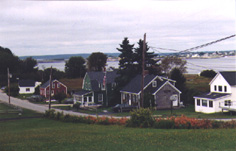
|
It was then on to look at
Wiscasset which claims to be the
prettiest village in Maine. We were
disappointed since the busy main Route 1 went
through the centre, so we quickly drove on to
Boothbay Harbour
which was a much more attractive area with water
on three sides, numerous islands and inlets as
well as hundreds of attractive boats lying at
anchor.
|
Thursday, 11 September 1997
Moving 210 miles south on our way to an SKP rally in
West Virginia we stopped overnight in Stafford,
CT in an almost empty campground. It seems in the northeast that the camping
season is very short with some campgrounds only open for 60 days and many only
open for about 90 days. The terrain continues to be mainly low hills covered in
a variety of trees.
Friday, 12 September 1997
The direct route further south would take us through New
York however driving the RV down Broadway did not appeal so we camped at
Platteskill which is about 50 miles from New
York's downtown district, planning to take a guided tour which started from
the campground the following morning.
Saturday, 13 September 1997
By 07.00 as the soft autumn sunshine was just appearing through the trees we
were already on our way to tour the Big Apple
along with 38 fellow campers. The 50-mile journey to catch the boat to the
Statue of Liberty went quickly as Dennis,
our ex-New York cop tour guide was amusing and full of useful information about
the city he had lived in all his life.
|
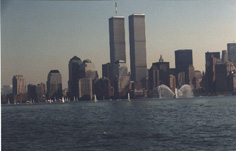
|
New York
covers an area of 32l sq. miles, has four
international airports and its harbour is the
second busiest in the world with ocean-going
vessels entering or leaving every 20 minutes.
The city with a population of 7.2 million
consists of five counties,
Manhattan, Queens,
Brooklyn,
Staten Island
and the Bronx which
is the only part on the mainland.
|
Dennis believes that dramatic improvements have been made to the City during the
past four years resulting in far less crime, graffiti and vagabonds on the
streets and according to the latest information New York is now safer
than many other US cities. It amused(?) us somewhat when he said that any
passenger carrying a gun should see him before visiting the sights.
|
While we waited with about a
thousand others at Battery (of
cannons) Park for the first boat
of the day to the statue, we
were entertained by singers and
acrobats. No doubt like many
others, we assumed that the
Statue of Liberty was in
New York, however, the
statue is on an island within
the state of
New
Jersey whose border
adjoins New York's along
the centre of the wide
Hudson
River.
The statue was presented to the
United States by France in 1884
in commemoration of the two
countries' alliance during the
American Revolution. Measuring
151 feet high and standing on a
pedestal 156 feet high, it is
the tallest statue of modern
times.
|
|
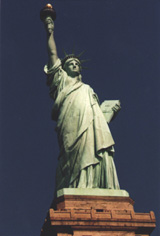
|
|
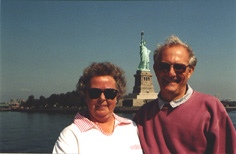
|
Because we were on a tour with lots of other
places to visit that day, we did not have enough
time to climb the 374 steps to the crown however
we did ascend to the top of the pedestal where
we had a marvellous view of the harbour and
Manhattan skyline. The green statue is an
imposing sight dominating the approach into the
harbour, however, and it must have been a
welcoming sight to millions of immigrants coming
to the USA.
|
|
New York
is proud of its special food so for lunch, we
had bagels with a smear and lox, delicious but
too much to eat - points to those who know what
we ate. This was followed by a visit to
Pier 17, the
Brooklyn Bridge
opened in 1883 and the
Southern
Street Seaport, where two multi-masted
sailing ships were moored alongside huge
skyscrapers.
|
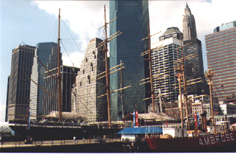
|
Rejoining the coach we then saw Wall Street
which was originally a wall built by the Dutch to keep out Indians, the British
made it a street in l699. A huge Chinese quarter, Soho with its 19th century
wrought iron constructed buildings and then it was on to explore the
Empire State building.
The building was completed in 1931, soaring 1,454 feet with 2 million square
feet of office space. One of the numerous elevators rushed us up 80 floors in
forty seconds and then we took a second elevator to the observation deck. The
building is made of Indiana limestone and granite trimmed with sparkling
stainless steel. The marble in the lobby was imported from Belgium, France,
Germany and Italy. The top 30 floors of the building are lit year-round from
dusk to midnight. The colour of the lights changes with the season and includes
red, white and blue for national holidays and red and green for the Christmas
season. We were fortunate to have a clear day so the view was fantastic, the
yellow cabs looking just like dinky toys.
After watching part of a wedding in the wonderful gothic
St. Patricks Cathedral where some of
the Kennedy family have been married, it was on to
Central Park, the Rockerfella Centre
and our final stop found both of us singing on Broadway
and tasting a hot Konishi. The city was an exciting place to visit, somewhat
like London except for the skyscrapers, however, we wondered what it must be
like during the working week when millions of workers pour into the downtown and
financial districts.
Sunday, 14 September 1997
Stopped for the night in Kutztown PA, 160 miles
further south, and watched the TV premier of Fools Rush In - only 6 out of 10.
Monday, 15 -18 September 1997
While in Boston a few weeks ago we met Keith and Pricilla Pippin both are
also SKPs on route to the rally and like ourselves wanted to visit
Washington DC, so we arranged to meet up with
them and explore the city together. We later learnt that Keith was not only
decorated with a purple heart as a helicopter gunner but is one of only about
100 people in the world who has run the 146 miles from Death Valley to the
9,000-foot Whitney Peak in 48 hours and this was during mid-summer! What is more
remarkable is that he did this at the age of 56. We spent three days exploring
Washington DC with them, leaving the car on the outskirts of town and
taking the fast, modern Metro into the central district.
Capital of the Nation, Washington DC is notched out of the state of
Maryland at the confluence of the Anacostia and
Potomac rivers. It is home to a multitude of federal offices and national
organisations including the White House,
Pentagon and Capital
Hill as well as numerous monuments and museums. It is built to the grand
design of Pierre L'Enfant, a French soldier and engineer, who forged a visionary
city of monuments, broad avenues and spacious circles. We both found the capital
to be impressive with its wide almost traffic-free straight roads linking most
of the major buildings in a way that one could see many of the attractions from
numerous vantage points. A good example is the
Lincoln Memorial which is in direct line with the Capitol and the
Washington Monument. Between the memorial and the monument lie two reflecting
pools with a combined length of 2,292 feet which add an extra dimension.
Lincoln's stately marble structure, designed by Henry Bacon, stands just before
the approach to Arlington Memorial Bridge.
The 36 columns, one for each state in existence at the time of Lincoln's death,
symbolise the Union. Dominating the interior is the colossal seated statue of
Lincoln by Daniel Chester French. Carved into the internal wall next to the
statue are the Gettysburg and the Second Inaugural Address. We found Lincoln's
statue managed to project the impression of a powerful, wise and compassionate
man.
Along with thousands of others, we toured the White House which has been
the home of every president except George Washington. It was designed by James
Hoban and the North Wing was completed in 1800, however, most of it was burnt by
the British in 1814. When the mansion was reconstructed, its fire-blackened
surfaces were painted white; thus originated the name "White House." We saw the
East, Green, Blue and Red rooms, the State Dining Room on the State floor and
the Vermeil Room and Library on the ground floor. Not surprisingly we were
unable to visit the West Wing, where the President's
Oval Office is located, which was constructed in 1902. It's an
impressive almost beautiful building standing in reasonable size grounds, with
light and airy rooms which remain furnished as determined by several notable
First Ladies including Jackie Kennedy.
Keith and George persuaded the girls that we should visit the
National Air and Space Museum,
which is devoted to the history and development of air and space technology and
is one of the world's most popular museums. As always George found the space age
displays enjoyable, however, Cape Canaveral has much more to offer and we were
disappointed that there was very little information about the recent exploration
of Mars. It was then off to the
National Museum of American History which depicts the scientific,
cultural, technological and political development of the United States. The
collection encompasses a bewildering array of exhibits about every facet of
American life. Venerated objects like the "star-spangled Banner" inspired the
writing of the national anthem to share the halls with such notable items as
George Washington's tent and an Edison light bulb.
At 490 feet the observation room of the
Washington Monument provides commanding views of the city and in
particular the Lincoln's Memorial to the west, Capital Hill to the
east, the White House to the north and the
Jefferson Memorial to the south. It is a simple slightly tapered
marble monument standing on a knoll surrounded by 50 American flags.
Friday, 19 - Sunday, 21 September 1997
Having spent about two weeks visiting big cities we were keen to return to the
countryside and fortunately our journey to Lewisburg
to attend the SKP fall rally, took us first through
Virginia with its rolling tree-covered hillsides and then into the more
mountainous terrain of West Virginia. We stopped for one night at the
Endless Caverns campground in New Market which
was deserted but we could not summon up the energy to find out if the caverns
were endless. We arrived in Lewisburg, WV the day before the rally
started so we boondocked overnight in the Walmart car park with about 40 other
SKPs in a variety of RVs which almost became a rally in its own right.
Monday, 22 - Thursday, 25 September 1997
|

|
|
The rally turned out to be a
marvellous occasion for renewing
acquaintances with many of the
friends we have made during the
past 18 months. It is quite
remarkable considering the size
of the USA how we keep meeting
up with the same people in a
variety of different locations.
Even though 974 RV's attended
the rally it turned out by
chance that we were camped next
to two couples we had travelled
to Mexico with, which
provided a good reason to
celebrate with a drink or two.
|
Later on, we found Bill & Bev who had we had visited in Michigan, they
had arrived a week earlier as they had volunteered to help set up the rally.
During the week we were made life members of the LEO Club which were founded by
Leo Kotte who has an identical rig and travelled with us to Mexico. As we have
reported several times before Americans love to eat out and in particular SKPs
seem to eat most of the time, so at about 5.00 PM the cry goes up Lets Eat Out,
hence the LEO Club.
Each day we were faced with a bewildering choice of seminars, crafts or BOF's
activities. Amongst others, Valerie went to seminars on woman's health and RV
maintenance for women and at one of the craft, sessions made a windowsill angel.
In the meanwhile, George learnt about the latest developments in cellular
phones, better video techniques, membership campgrounds, safety while
travelling, ham radio and tips when visiting Mexico and Quartzite.
Before the evening entertainment everybody gathers for the free door prizes
where for about 50 minutes membership numbers are continuously drawn out of the
barrel for a bewildering range of prizes including cruises to Hawaii, we won a
bottle of black tank treatment!
There was so much to do that the five days flew by and all too soon it was time
to say farewell to so many friends, however, we can look forward to meeting up
with some of them early next summer as we plan to travel to Alaska together.
Friday, 26 September 1997
It was time to start the 2,500-mile drive to Los Angles to meet Doug and
Ivy. As several problems needed to be fixed on the car and have had a bad
experience with official dealerships not having parts in stock, we had asked for
the parts to be pre-ordered by Suzuki dealers in Beckley
about 50 miles west from the rally. Initially, things looked good as we were
able to park the RV in Walmart which was opposite the dealer where the car was
being repaired. However, by mid-afternoon, we were told that they did not have
one of the parts and they could not obtain it until Monday in the meanwhile the
car could not be driven. We now know how Tony Austin must have felt on many
occasions with the poor service from American maintenance shops.
Saturday, 27 September 1997
As it turned out we found an attractive campground overlooking
Victoria Lake which is shaped like a long
fishbone with numerous spines. The campground had organised a lunchtime pig
roast and all campers were invited to join in. Incredible quantities of food
were spread over long tables which we enjoyed in the pleasant fall sunshine.
Sunday, 28 - Monday, 29 September 1997
It rained all day Sunday without a single break in the clouds, which if nothing
else provided an opportunity to deal with our mail from the UK which had been
forwarded to the SKP rally. Valerie's mood matched the weather as she pondered
what to do if the parts for the car do not arrive on Monday, therefore, making
getting to LA on time more difficult.
As it turned out the parts did not arrive and the latest promise when George
checked with the service department was Tuesday, which would make it four days
since the car was taken in for a two-hour repair! We have concluded that the
average US auto service centre is worse than those back home, which has little
to shout about. Spent most of Monday shopping and washing the RV.
Tuesday, 30 September 1997
By 11.00 we parked the RV outside the service centre where to our relief we
found that the parts had arrived and the car was being completed. However, our
relief was short-lived since upon checking George found that several items were
missing from the car including the camera, which we would not have left in the
car if we had realised the repair would take more than a few hours. As expected
the service centre did not want to know even when George saw the manager and
asked them to call the police. At the end of the day, we were just pleased to
get the car road-worthy and travelling west, 175 miles later we camped for the
night at a nice campground at Slick Rock,
Kentucky. >>>
Home








